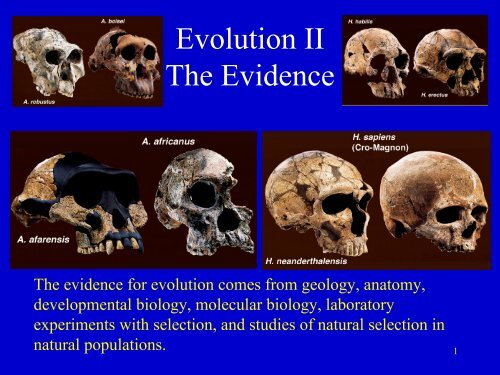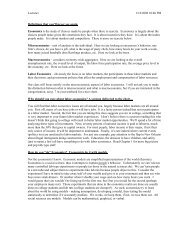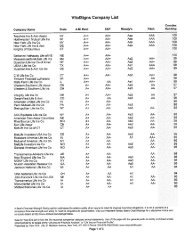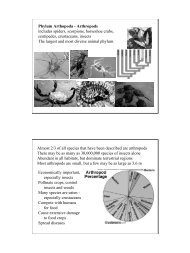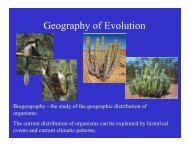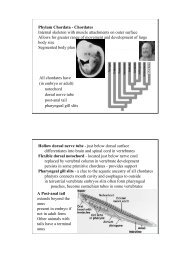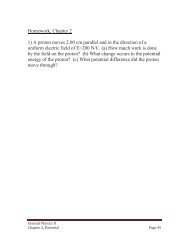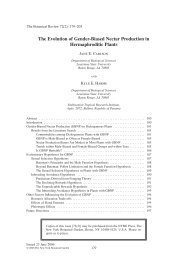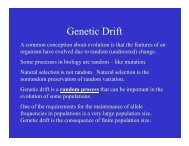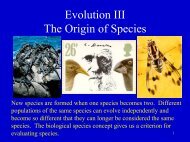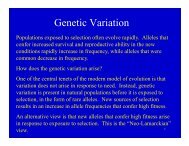Evidence for Evolution.pdf
Evidence for Evolution.pdf
Evidence for Evolution.pdf
You also want an ePaper? Increase the reach of your titles
YUMPU automatically turns print PDFs into web optimized ePapers that Google loves.
<strong>Evolution</strong> IIThe <strong>Evidence</strong>The evidence <strong>for</strong> evolution comes from geology, anatomy,developmental biology, molecular biology, laboratoryexperiments with selection, and studies of natural selection innatural populations.1
Geology provides the most direct evidence <strong>for</strong> evolution.We know a great deal from geology, including that• the earth is about 4.5 billion years old,• the earliest known cells are found in 3.5 billion year old rocks• the earliest known eukaryotic cells date to 1.5 billion years• the earliest multicellular animals date to 650 million years• the earliest land animals date to about 450 million years• the earliest mammals date to about 230 million years• 65 m.y. ago there was a mass extinction of many living things• the human family tree diverged from the other apes about 4.5million years agoThe record in the rocksindicates a gradualevolutionary progressionfrom simpler to morecomplex2
Fossils found inrocks have allowedpaleontologists totrack the evolution ofmany organisms,some in fine detail.3
The family tree of horses is welldocumented in fossils.The ancestor of all horses was asmall <strong>for</strong>est-dwelling leafbrowser.Many of the changes seen inhorses through time correlatedwith environmental change.As grasses became morecommon, horses evolved tobecome better grazers of grassesand faster runners in opengrasslands.4
How are fossils dated?The fossils themselves are seldom dated but layers of rock aboveand below the fossils sometimes provide rocks of a type that can bedated with radioisotopes. The rock dates bracket the fossil’s age.One type of radioisotope dating is K/Ardating. Radioactive 40 K decays to 40 Ar at aknown rate (one half-life = 1.26 billionyears). Because 40 Ar is a volatile gas, anyrock that was heated to a high temperaturein the past would have had no 40 Ar in itwhen it cooled. So, any 40 Ar today wouldhave been <strong>for</strong>med through the decay of 40 K.The sum of the content of 40 K and 40 Ar in the rock today equals thetotal amount in the rock in the distant past. The relative amount ofthe two elements indicates how old the rock is.5
The anatomy of many organisms indicates they evolved from acommon ancestor.Body parts that develop from the same embryonic tissues arecalled homologous. The <strong>for</strong>elimbs of all vertebrates are allhomologous structures and are modifications of the sameassemblage of bones and muscles.6
The anatomy of manyorganisms havevestigial structures.Vestigial structures haveno function, but arederived from structuresthat did have a functionin an ancestor of thatorganism.The pelvic girdle of whales and snakes do not support limbs andthus per<strong>for</strong>m no function.The appendix of humans is derived from a distant ancestor that atemore vegetation.7
Developmental sequences of organisms indicate common ancestry.All vertebrates go through the same stages in early development.As development proceeds, there is greater and greater divergencein <strong>for</strong>m, but closely related <strong>for</strong>ms, like humans and chimpanzees,share nearly identical developmental sequences until very late indevelopment.8
In the laboratory, experiments with selection have confirmed thatorganisms can change greatly in <strong>for</strong>m through selective breeding.9
Selective breeding ofdomesticated plants and animalshave results that are similar tolaboratory experiments andsometimes go beyond what is seenin nature.The gradual evolution of cornthrough selective breeding byNative Americans is recordedin archeological sites, in afashion similar to the recordof the evolution horses, etc.,recorded in fossils.10
Natural selection has been documented in nature many times.In Galapagos finches, available seed sizes change with differentamounts of rainfall. Dry years result in more large seeds. Wetyears result in more smaller seeds. Studies of reproductivesuccess in finches indicate that large-billed birds have higherfitness in dry years, and small-billed birds have higher fitness inwet years. Fitness is reflected in the offspring produced duringwet and dry years. The pattern is repeatable and predictable.11
Molecular studies of genetic similarity support estimates ofevolutionary relationship from the fossil record and anatomicalstudies. Many independent lines of evidence all support theconclusion that all living things share common ancestors.12


